Blank L., Tarquin A. Engineering Economy (McGraw-Hill Series in Industrial Engineering and Management)
Подождите немного. Документ загружается.

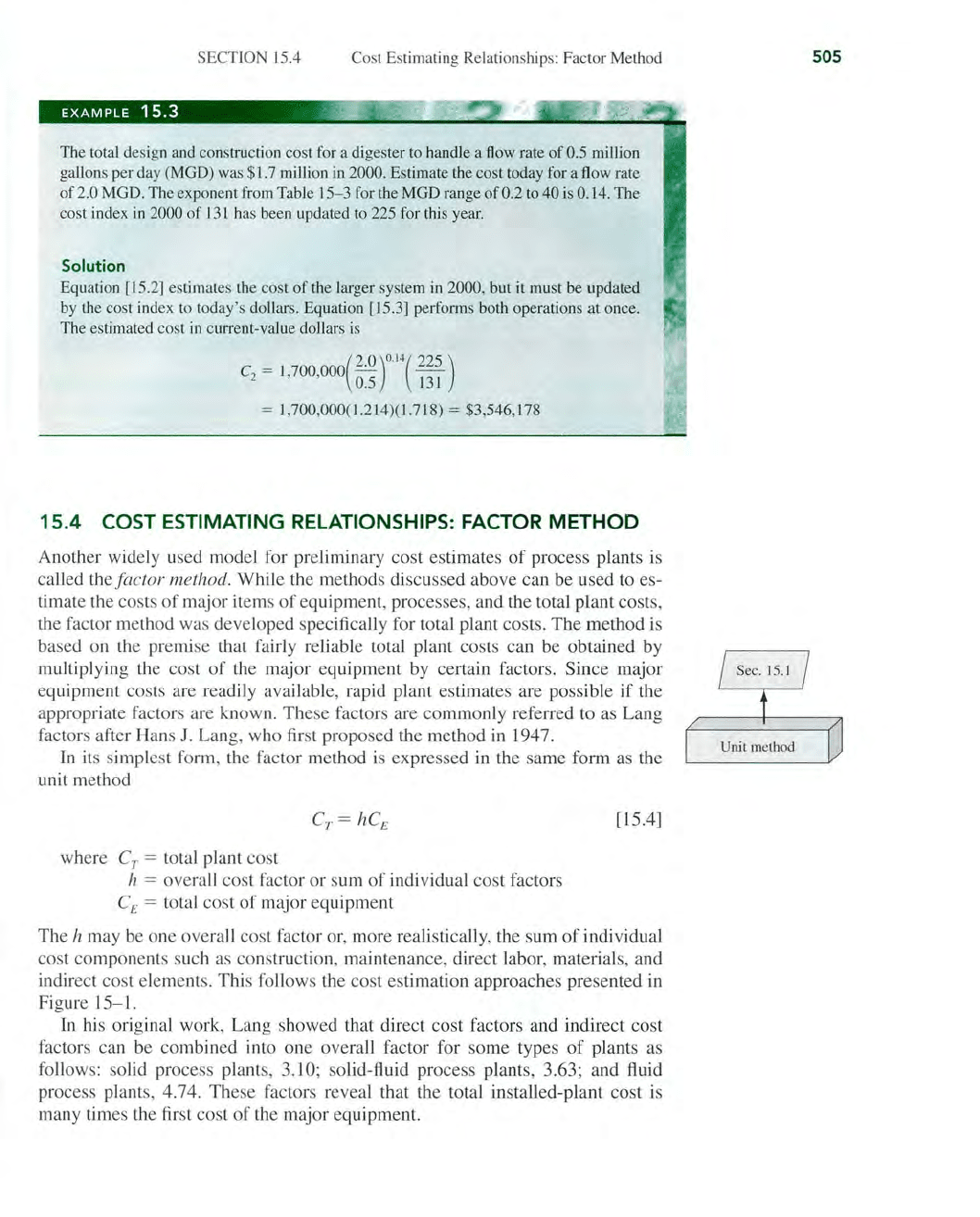
SECTION 15.4
Cost Estimating Relationships: Factor Method
EXAMPLE
15.3
l'
The total design and construction cost for a digester to handle a flow rate
of
0
.5
million
gallons
per
day (MOD) was $1
.7
million in 2000. Estimate the cost today for a flow rate
of2.0
MOD. The exponent from Table
15-3
for the
MOD
range
of
0.2 to
40is
0.
14
.
The
cost index
in
2000
of
13l
ha
s been updated to 225 for this year.
Solution
Equation [15.2] estimates the
cost
of
the larger system in 2000, but it must be updated
by the cost ind
ex
to today
's
dollars. Equation
[J
5.3] perfonns both operations
at
once.
The estimated cost in current-value dollars is
c = 1 700
OOO(
2.0
)O
.1
4(
225 )
2 ' , 0.5
131
= 1,700,000(1.214)(1.718) = $3,546,178
15.4 COST ESTIMATING RELATIONSHIPS: FACTOR METHOD
Another widely used model for preliminary cost estimates
of
process plants is
called the
factor method. While the methods discussed above can be used to es-
timate the costs
of
major items
of
equipment, processes, and the total plant costs,
the factor method was developed specifically for total plant costs.
The
method
is
based on the premise that fairly reliable total plant costs can be obtained by
multiplying the cost
of
the major equipment by certain factors. Since major
equipment costs are readily available, rapid plant estimates are possible if the
appropriate factors are known. These factors are commonly referred to as Lang
factors after Hans
J.
Lang, who
fir
st proposed the method
in
1947.
In
its
si
mplest form, the factor method is expressed in the same form as the
unit method
[15.4]
where
C
T
= total plant cost
h = overall cost factor or sum
of
individual cost factors
C
E
= total cost
of
major equipment
The
h may be one overa
ll
cost factor or, more realistically, the sum
of
individual
cost components such as construction, maintenance, direct labor, materials, and
indirect cost elements. This follows the cost estimation approaches presented in
Figure
J
5-1.
In
hi
s original work, Lang showed that direct cost factors and indirect cost
factors can be combined into one overa
ll
factor for some types
of
plants as
follows: solid process plants, 3.
J 0; solid-fluid process plants, 3.63; and fluid
process plants, 4.74. These factors reveal that the total installed-plant cost is
many times the first cost
of
the major equipment.
505
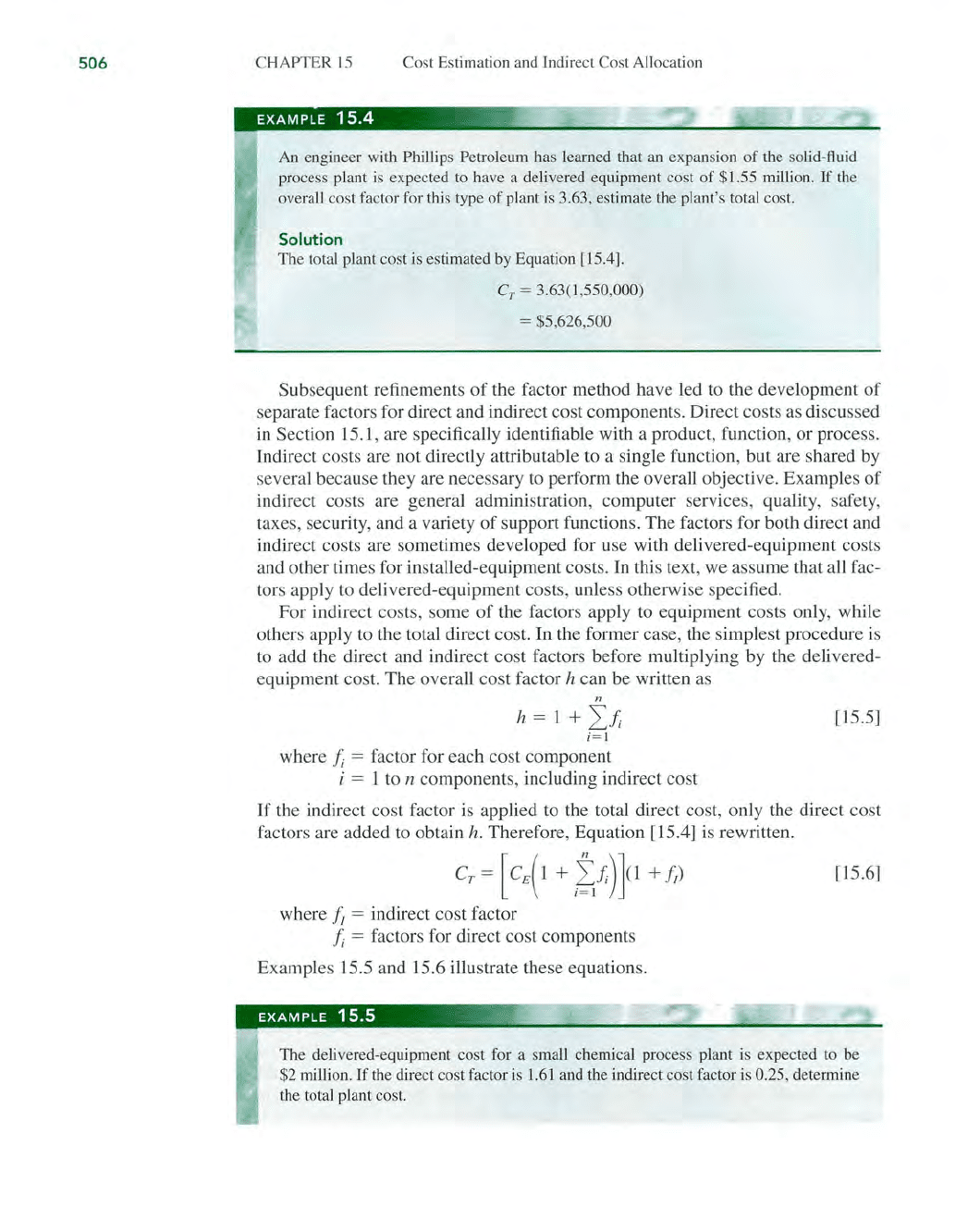
506
CHAPTER
15
Cost Estimation and Indirect Cost Allocation
EXAMPLE
15.4
An engineer with Phillips Petroleum has learned that
an
expansion
of
the solid-fluid
process plant
is
expected to have a delivered equipment cost
of
$1.55 million.
If
the
overall cost factor for this type
of
plant
is
3.63, estimate the plant's total cost.
Solution
The total plant cost is estimated
by
Equation [15.4].
C
T
= 3
.6
3(1
,550,000)
= $5,626,500
Subsequent refinements
of
the factor method have led
to
the development
of
separate factors for direct and indirect cost components. Direct costs
as
discussed
in
Section
lS.l,
are specifically identifiable with a product, function, or process.
Indirect costs are not directly attributable
to
a single function, but are shared
by
several because they are necessary
to
perform the overall objective. Examples
of
indirect costs are general administration, computer services, quality, safety,
taxes, security, and a variety
of
support functions. The factors for both direct and
indirect costs are sometimes developed for use with delivered-equipment costs
and other times for installed-equipment costs. In this text, we assume that
all fac-
tors apply
to
delivered-equipment costs, unless otherwise specified.
For indirect costs, some
of
the factors apply to equipment costs only, while
others apply to the total direct cost. In the former case, the simplest procedure is
to
add the direct and indirect cost factors before multiplying
by
the delivered-
equipment cost. The overall cost factor
h.
can be written as
"
h.
= 1 + 'il;
[lS
.
S]
i= 1
where
I;
= factor for each cost component
i = 1
to
n components, including indirect cost
If
the indirect cost factor
is
applied to the total direct cost, only the direct cost
factors are added to obtain
h.
. Therefore, Equation [lS.4] is rewritten.
C
T
= l C
E
(
I +
~I;)
JO
+
J;)
[IS.6]
where
J;
= indirect cost factor
I;
= factors for direct cost components
Examples
IS.S
and IS.6 illustrate these equations.
EXAMPLE 15.5
~~
The delivered-equipment cost for a sma
ll
chemical process plant
is
expected to be
$2 million.
If
the direct cost factor is
1.61
a
nd
the indirect cost factor
is
0.25, determine
the total plant cost.

SECTION 15.4 Cost Estimating Rela
ti
onships: Factor Method
Solution
Since all factors apply
to
the delivered-equipment cost, they are added
to
obtain h, the
total cost factor
in
Eq
uation
lI5
.5
].
h = I +
1.61
+ 0.25 = 2.86
From Equation [15.4], the to
tal
plant cost is
C
T
= 2.86(2,000,000) = $5,720,000
EXAMPLE 15.6
An activated sludge wastewater treatment plant is expected
to
have the following
delivered-equipment
fir
st costs:
Equipment Cost
Prelimina
ry
tr
eat
ment
Primary treatment
Activated sludge
Clarification
Chlorination
Diges
ti
on
Vacuum
fi
ltration
Total cost
$30,000
40,000
18,000
57,000
31,000
70,000
27,000
$273,000
The
cost factor for the
in
sta
ll
ation
of
pip
in
g, concrete, steel, insulation, supports, etc., is
0.49.
The
con
st
ru
ction factor is 0.53, a
nd
the indirect cost factor
is
0.21 . Determine the
total plant cost
if
(a) all cost factors are app
li
ed
to
the cost
of
the delivered-equipment
and
(b)
th
e indirect cost factor is applied to the total direct cost.
Solution
(a) Total equipment cost is $273,000. Since both the direct and indirect cost
factors are applied
to
only the equipment cost, the overall cost factor from Equa-
tion [15.5] is
h = I + 0.49 + 0.53 + 0.21 = 2.23
The
total
pl
an
t cost is
C
r
= 2
.2
3(273,000) = $608,790
(b) Now the
tOlal
direct cost is calc
ul
ated first, and Equation [15.6] is used to esti-
mate the total plant cos
t.
"
h = 1 + IJ = 1 + 0.49 + 0.53 = 2.02
i= 1
C
T
= [273,000(2.02)](1.21) = $667,267
Comment
Note the decrease
in
estimated plant cost when the indirect cost is applied to the equip-
ment cost only
in
part (a). This illustrates the importance
of
determining exactly what
the factors apply
to
before they are used.
507

508
CHAPTER
15
Cost Estimation and Indirect Cost Allocation
15.5 TRADITIONAL INDIRECT COST
RATES
AND
ALLOCATION
Costs incurred
in
the production
of
an item or delivery
of
a service are tracked
and assigned
by
a cost accounting system. For the manufacturing environment, it
can be stated generally that the
statement
of
cost
of
goods sold is one end prod-
uct
of
this system.
The
cost accounting system accumulates material costs, labor
costs, and indirect costs (also called overhead costs or factory expenses) by using
cost centers. All costs incurred in one department
or
process line are collected
under a cost center title, for
exam
ple, Department 3X. Since direct materials and
direct labor are usually directly assignable to a cost center, the system need only
identify and track these costs.
Of
course, this in itself is no easy chore, and the
cost
of
the tracking system may prohibit collection
of
all direct cost data
to th
e
level
of
detail desired.
One
of
the primary and more difficult tasks
of
cost accounting is the allocation
of
indirect costs when
it
is
necessary to allocate them separately to departments,
processes, and product lines. The costs associated with property taxes, service
and maintenance departments, personnel, legal, quality, supervision, purchasing,
utilities, software development, etc., must be allocated to the using cost center.
Detailed co
ll
ection
of
these data
is
cost-prohibitive and often impossible; thus,
allocation schemes are utilized to distribute the expenses on a reasonable basis.
A listing
of
possible bases is included
in
Table 15-4. Historically common bases
have been direct labor cost, direct labor hours, machine-hours, number
of
em-
ployees, space, and direct materials.
Most allocation is accomplished utilizing a predetermined
indirect cost rate,
computed by using the general relation.
I d
·
t t t estimated indirect costs
n lrec cos
ra
e =
estimated basis level
[15.7]
The
estimated indirect cost is the amount allocated to a cost center. For example,
if a division has two producing departments, the total indirect cost allocated to a
department
is
used as the numerator
in
Equation [15.7] to determine the depart-
ment rate. Example
15.7
illustrates allocation when the cost center is a machine.
TABLE
15-4
In
direct Cost A
ll
ocation Bases
Cost
Category
Taxes
Heat,
li
ght
Power
Receiving, purchasing
Personnel, machine shop
Building maintenance
Software
Quality control
Possible Allocation Basis
Space occupied
Space, usage, number
of
outlets
Space, direct labor hours, horsepower
-h
ours, machine
hOUTS
Cost
of
materials, number
of
orders, number
of
items
Direct labor hours, direct labor cost
Space occupied, direct labor cost
Number
of
accesses
Number
of
inspections
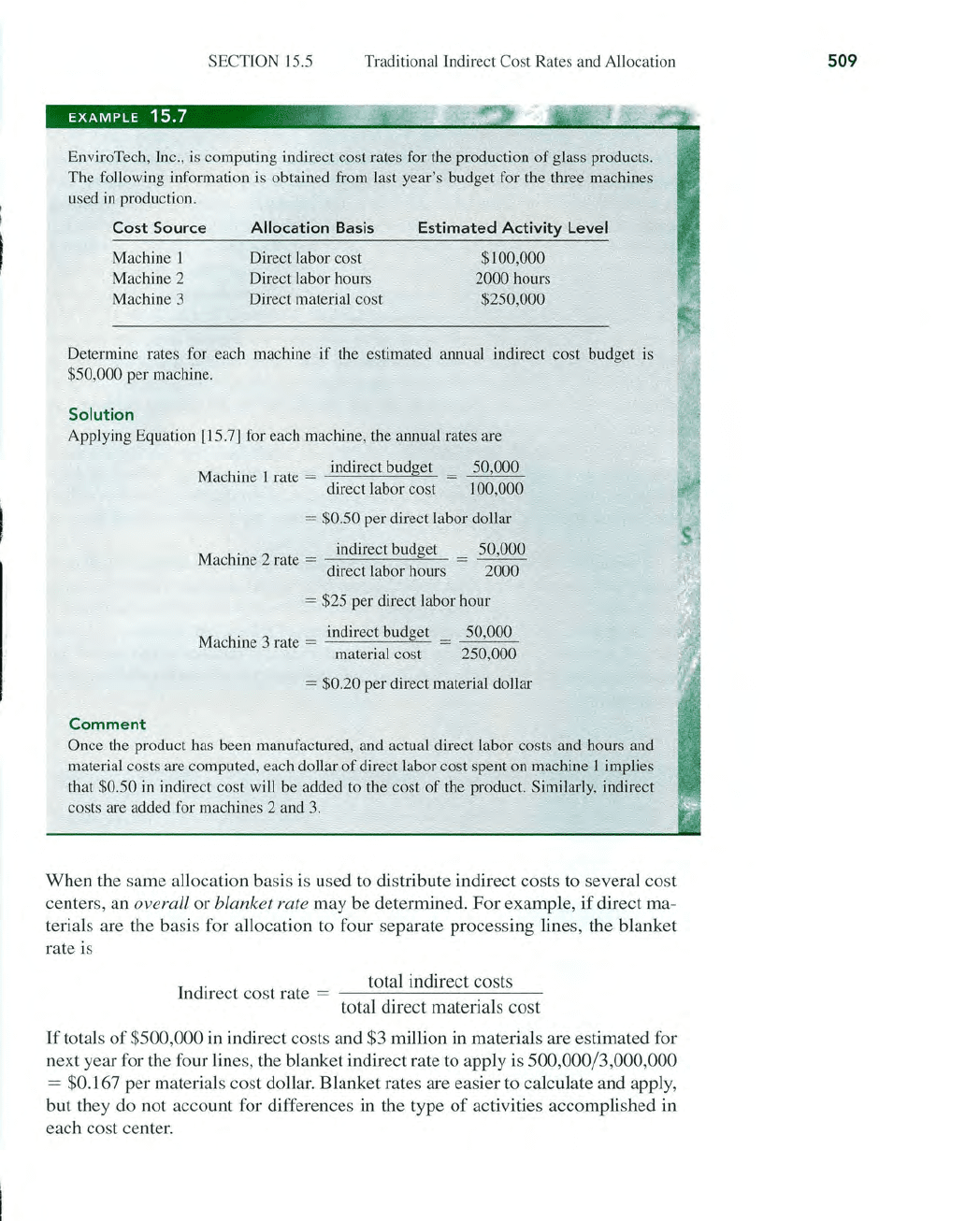
SECTION
15.5
Traditional Indirect Cost Rates and Allocation
EXAMPLE
15.7
'1".
EnviroTech, Inc., is computing indirect cost rates for the production
of
glass products.
The following information is obtained from last year's bndget for the three machines
used
in
production.
Cost
Source
Allocation Basis
Estimated
Activity Level
Machine 1
Machine 2
Machine 3
Direct labor cost
Direct labor hours
Direct material cost
$100,000
2000
hours
$250,000
Determine rates for each machine
if
the estimated annual indirect cost budget is
$50,000
per
machine.
Solution
Applying Equation [15.7J for each machine, the annual rates are
Comment
M
h
· I
indirect budget
...:.
5...:.0,-",0..:..:00:.-
·
ac me rate = = -
direct labor cost 100,000
= $0.50 per direct labor dollar
M
h
·
2
_::ci
n:.:.;d
=i::.:r
e:...:c-,-t
..::.
b..::.u..::cdgQ.e:..:t_
ac me rate = .
dIrect labor hours
50,000
2000
=
$25
per direct labor hour
M
h
·
3 indirect
budgetS
,:...:0,-,-,0,,-0:...:0,-
ac me rate = = -
material cost 250,000
= $0.20 per direct material dollar
Once the product has been manufactured, and actual direct labor costs and hours and
material costs are computed, each dollar
of
direct labor cost spent on machine 1 implies
that
$0.50 in indirect cost will be added to the cost
of
the product. Similarly, indirect
costs are added for machines 2 and
3.
When the same allocation basis is used
to
distribute indirect costs to several cost
centers,
an
overall or blanket rate may be determined. For example, if direct ma-
terials are the basis for allocation
to
four separate processing lines, the blanket
rate is
Indirect cost rate
=
total indirect costs
total direct materials cost
If
totals
of
$500,000
in
indirect costs and
$3
million in materials are estimated for
next year for the four lines, the blanket indirect rate
to
apply
is
500,000/3,000,000
= $0.167 per materials cost dollar. Blanket rates are easier
to
calculate and apply,
but they do not account for differences in the type
of
activities accomplished in
each cost center.
509
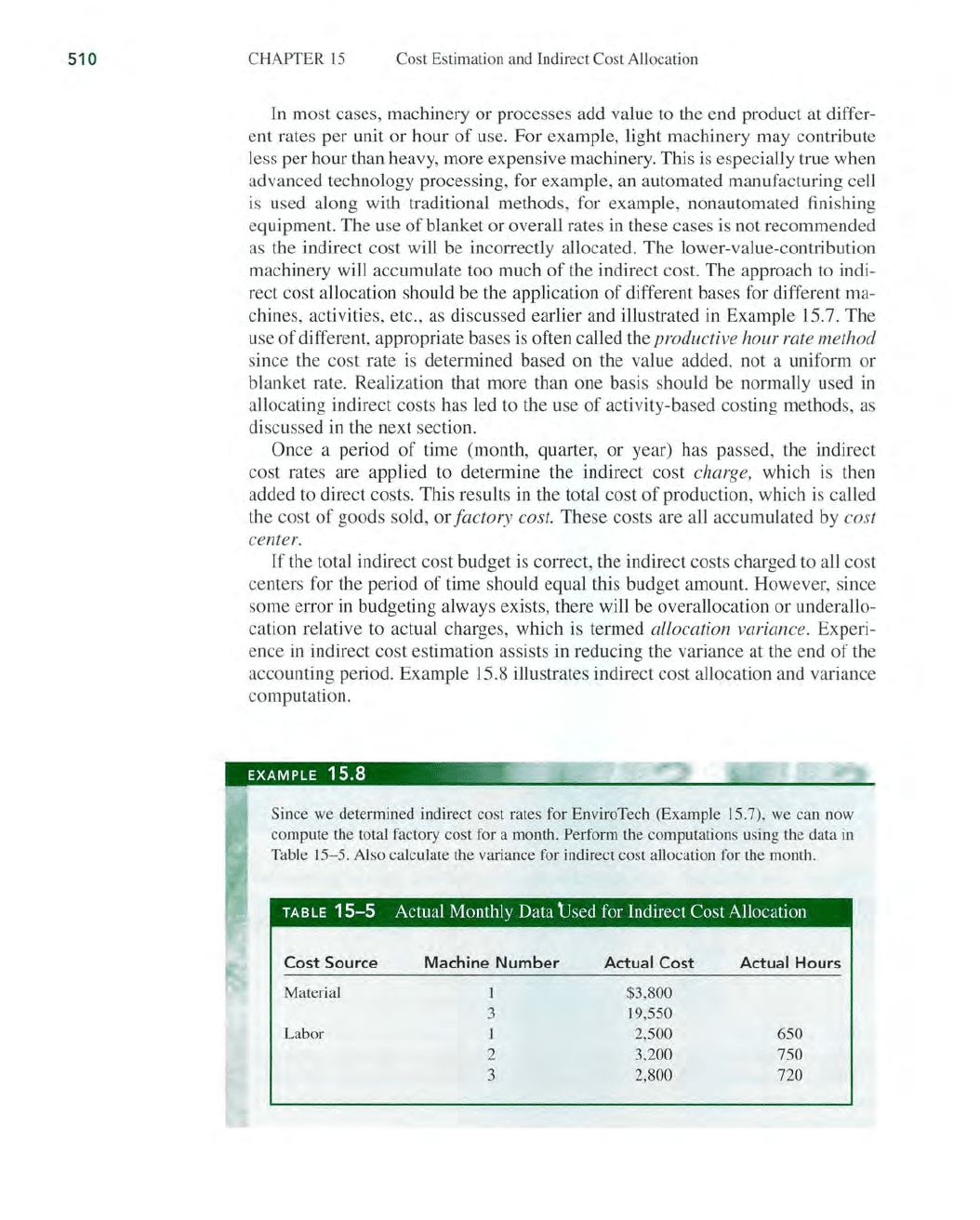
510
CHAPTER
15
Cost Estimation and Indirect Cost Allocation
In most cases, machinery or processes add value to the end product at differ-
ent rates per unit or hour
of
use. For example, light machinery may contribute
less per hour than heavy, more expensive machinery. This
is
especially true when
advanced technology processing, for example, an automated manufacturing cell
is used along with traditional methods, for example, nonautomated finishing
equipment.
The
use
of
blanket or overall rates in these cases is not recommended
as the indirect cost will be incorrectly allocated.
The
lower-value-contribution
machinery will accumulate too much
of
the indirect cost.
The
approach to indi-
rect cost a
ll
ocation should be the application
of
different bases for different ma-
chines, activities, etc
.,
as
discussed earlier and illustrated in Example 15.7.
The
LIse
of
different, appropriate bases is often called the productive hour rate method
since the cost rate is determined based on the value added, not a uniform
or
blanket rate. Realization that more than one basis should be normally used
in
allocating indirect costs has led to the use
of
activity-based costing methods, as
di
scussed
in
the next section.
Once a period
of
time (month, quarter, or year) has passed, the indirect
cost rates are applied to determine the indirect cost
charge, which
is
then
added to direct costs. This results in the total cost
of
production, which is called
the cost
of
goods sold, or factory cost.
The
se costs are all accumulated by cost
center.
If
the total indirect cost budget is correct, the indirect costs charged to all cost
centers for the period
of
time should equal this budget amount. However, since
some
etTor in budgeting always exists, there will be overallocation or underallo-
cation relative to actual charges, which is termed
allocation variance. Experi-
ence
in
indirect cost estimation assists in reducing the variance at the end
of
th
e
accounting period. Example
15
.8
illustrates indirect cost allocation and variance
computation.
EXAM
PLE
15.8
~.,'
Since we determjned indirect cost rates for EnviroTech (Example 15.7), we can now
compute the total factory cost for a month.
Perform the computations using the data
in
Table 15-5. Also calculate the variance for indirect cost allocation for the month.
TABLE
15-5
Ac
tu
al Monthly Data 'Used for
In
direct Cost A
ll
ocation
Cost
So
u
rce
Mach
ine
Numbe
r A
ctual
C
os
t
Actu
al
Hours
Material
I $3,800
3
19
,550
Labor
1 2,500
650
2 3,200 750
3 2,800 720

SECTION 15.5 Traditional Indirect Cost Ra
te
s a
nd
Allocation
Solution
Start with the cost
of
goods so
ld
(factory cost) relation given
by
Equation [B.l] in
Appendix B, which is
Cost
of
goods so
ld
= direct mate
ri
als + direct labor + indirect costs
To
determine indirect cost, the rates from Example 15.7 are applied:
Mac
hin
e 1 indirect = (labor cost)(rate) = 2500(0.50) = $1250
Machine 2 indirect = (labor hours)(rate) = 750(25.00) = $18,750
Machine 3 indirect
= (material cost)(rate) = 19,550(0.20) = $3910
Total charged indirect cost
= $23,910
Factory cost is the sum
of
actual material and labor costs from Table
15
- 5 and the indi-
rect cost charge for a total
of
$55,760.
Ba
se
d
on
the annual indirect cost budget
of
$50,000 per machine, one month repre-
sents 1/
12
of
the total or
M thl b d
3(50,000)
on
y u get =
12
= $12,500
The variance for total indirect cost is
Variance
= 12,500 -
23
,910 =
$-11,410
This is a large budget underallocation, since much more was charged than allocated.
The
$12,500 budgeted for the three machines represents a 91.3% underallocation
of
in-
direct costs. T
hi
s analysis for only one month
of
a year will most likely prompt a rapid
review
of
th
e rates and the indirect cost budget for EnviroTech.
Once estimates
of
indirect costs are determined, it is possible to perform an
economic analysis
of
the present operation versus a proposed operation. Such a
study
is
described
in
Example
15
.
9.
EXAMPLE
15.9
':.~'
For several yea
rs
the Cuisinart Corporation has purchased the carafe assembly
of
its
major coffee-maker line at
an
annual cost
of
$1.5 million. The suggestion
to
make
the compone
nt
inhouse has been made. For the three departments involved the an-
nu
al indirect cost rate
s,
estimated material, labor, and hours are found in Table 15-6.
The a
ll
ocated hours column is the time necessary
to
produce the carafes for a
yea
r.
Equipment must be purchased with the following estimates:
fir
st cost
of
$2 million,
salvage
va
lue of
$5
0,000, a
nd
life
of
10
years. Perform an economic analysis for the
make alternative, assuming that a market rate
of
15
% per year is the MARR.
511
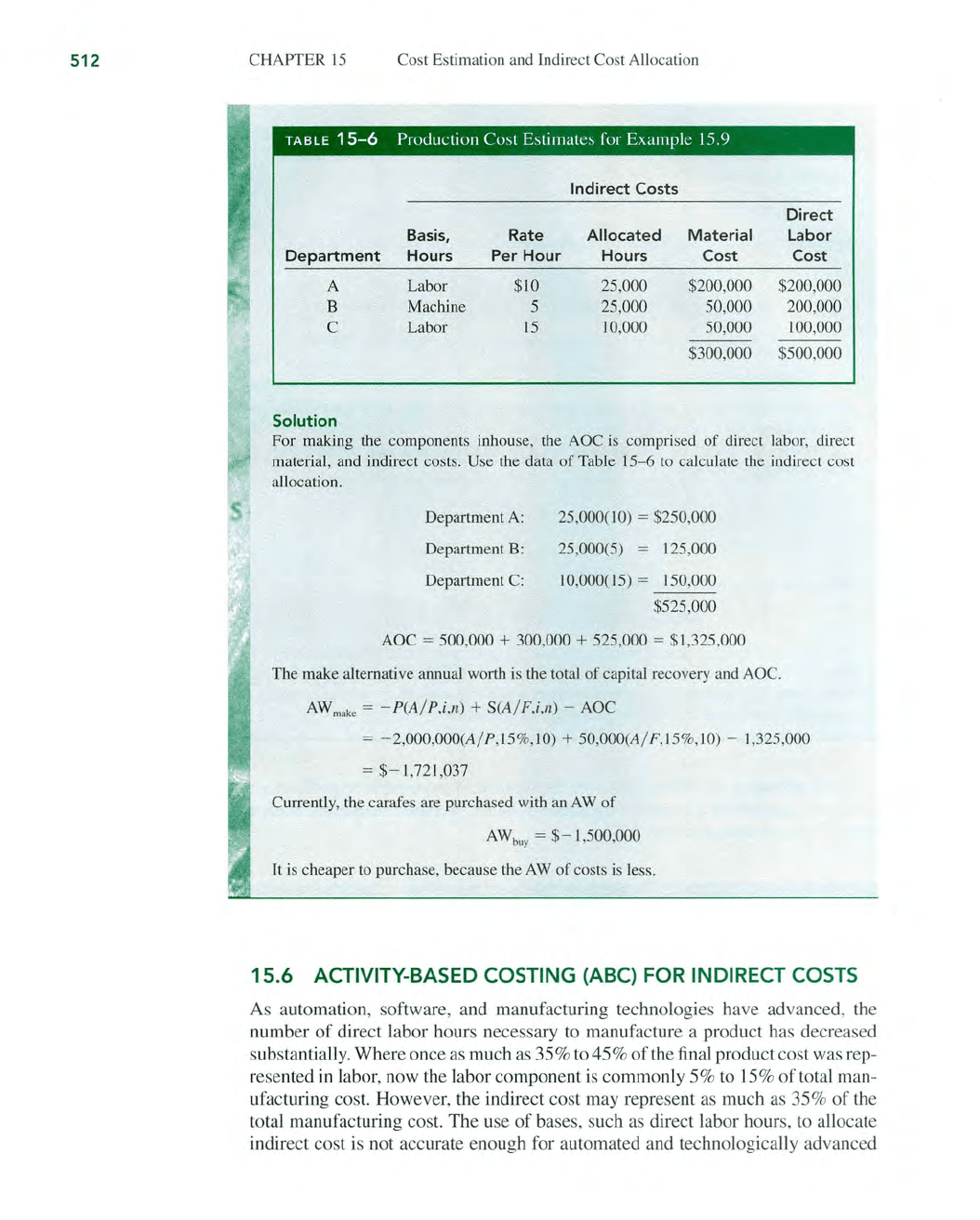
512
CHAPTER
15
Cost Estimation a
nd
Indirect Cost
All
oca
ti
on
TABLE
15-6
Production Cost Estimates for Example 15.9
Indirect
Costs
Direct
Basis, Rate Allocated Material Labor
Department
Hours
Per
Hour Hours
Cost
Cost
A
Labor
$10
25,000 $200,000 $200,000
B
Machine 5 25,000 50,000 200,000
C
Labor
15
10,000 50,000
100
,000
$300,000
$500,000
Solution
For making the components inhouse, the AOC is comprised of direct labor, direct
material, and indirect costs. Use the data
of
Table 15-6
to
calculate the indirect cost
allocation.
Department
A:
Department B:
Department
C:
25
,000(10) = $250,000
25
,000(
5)
=
125
,000
10
,000(15) = 150,000
$525,000
AOC
= 500,000 + 300,000 + 525,000 =
$1
,325,000
The make alternative annual worth is the total
of
capital recovery a
nd
AOC.
AW
make
=
-P(A
/ P,i,n) +
S(A
/ F,i,n) - AOC
= -2,000,000(A/ P,l5%
,1O)
+ 50,000(A/ F,
15
%
,LO
) - 1,325,000
= $- 1,
721
,037
Currently, the carafes are purchased with an
AW
of
AW
buy
= $- 1,500,000
It is cheaper
to
purchase, because the
AW
of
costs is less.
15.6 ACTIVITY-BASED
COS
TING (ABC)
FOR
INDIRECT
COSTS
As automation, software, and manufacturing technologies have advanced, the
number
of
direct labor hours necessary to manufacture a product has decreased
substantially. Where once as much as 35% to 45%
of
the final product cost was rep-
resented in labor, now the labor component is commonly 5% to
15
%
of
total man-
ufacturing cost.
However
, the indirect cost may represent as much as 35%
of
the
total manufacturing cos
t.
The
use
of
base
s,
such as direct labor hour
s,
to allocate
indirect cost is not accurate enough for automated and technologica
ll
y advanced
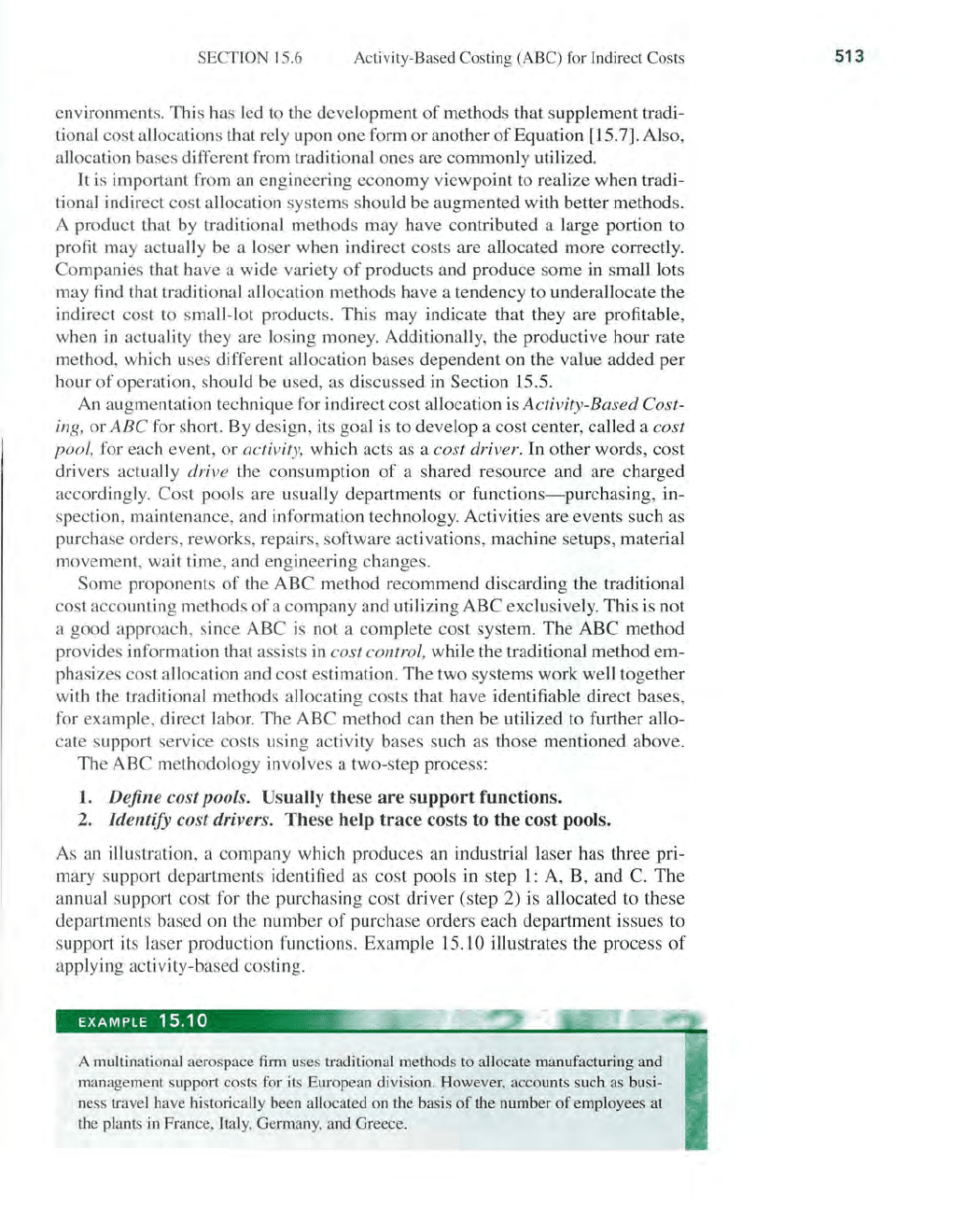
SECTlON
15.
6 Activity-Based Costing (ABC) for Indirect Costs
environment
s.
This has led
to
the development
of
methods that supplement tradi-
tional cost allocations that rely upon one form or another
of
Equation [15.7]. Also,
allocation bases different from traditional ones are commonly utilized.
It is important from an engineering economy viewpoint to realize when tradi-
tional indirect cost allocation systems should be augmented with better method
s.
A product
th
at by traditional methods may have contributed a large portion to
profit may actually be a loser when indirect costs are allocated more correctly.
Compa
ni
es that have a wide variety
of
products and produce some
in
small lots
may find that traditional allocation methods have a tendency to underallocate the
indirect cost
to
small-lot products. This may indicate that they are profitable,
when
in
ac
tu
ality they are los
in
g money. Additionally, the productive hour rate
method, which uses different allocation bases dependent on the value added per
hour
of
operation, should be used, as discussed in Section 15.5.
An augmentation technique for indirect cost allocation
is
Activity-Based Cost-
ing,
or
ABC
for short. By design, its goal is to develop a cost center, called a cost
pool,
for each event, or activity, which acts
as
a cost driver. In other words, cost
drive
rs
actually drive the consumption
of
a shared resource and are charged
according
ly
. Cost pools are usually departments or
functions-purchasing,
in-
spection, maintenance, and information technology. Activities are events such
as
purchase orders, reworks, repairs, software activations, machine setups, material
movement, wait time, and engineering changes.
Some proponents
of
the ABC method recommend discarding the traditional
cost accounting methods
of
a company a
nd
utilizing
ABC
exclusively. This is not
a good approach, since ABC is not a complete cost system.
The
ABC method
provides in
fo
rmation that assists
in
cost control, while the traditional method em-
phasizes cost allocation and cost estimation.
The
two systems work well together
with the traditional methods allocating costs that have identifiable direct bases,
for example, direct labor.
The
ABC method can then be utilized to further allo-
cate support service costs us
in
g activity bases such as those mentioned above.
The ABC me
th
odology involves a two-step process:
1. Define cost pools. Usually these
are
support
functions.
2. Identify cost drivers. These help trace costs to the cost pools.
As an illustration, a company which produces an industrial laser has three pri-
mary support departments identified
as
cost pools
in
step
1:
A,
B, and
C.
The
annual support cost for the purchasing cost driver (step 2)
is
allocated to these
departments based on the number
of
purchase orders each department issues to
support its laser production functions. Example 15.10 illustrates the process
of
applying activity-based costing.
EXAMPLE
15.10
,'/
A multinational aerospace firm uses traditional methods to allocate manufacturing and
management support costs for its European division. However, accounts such
as
busi-
ne
ss travel have
hi
storically been allocated on the basis
of
the number
of
employees at
the plants
in
France, Italy, Germany, a
nd
Greece.
513
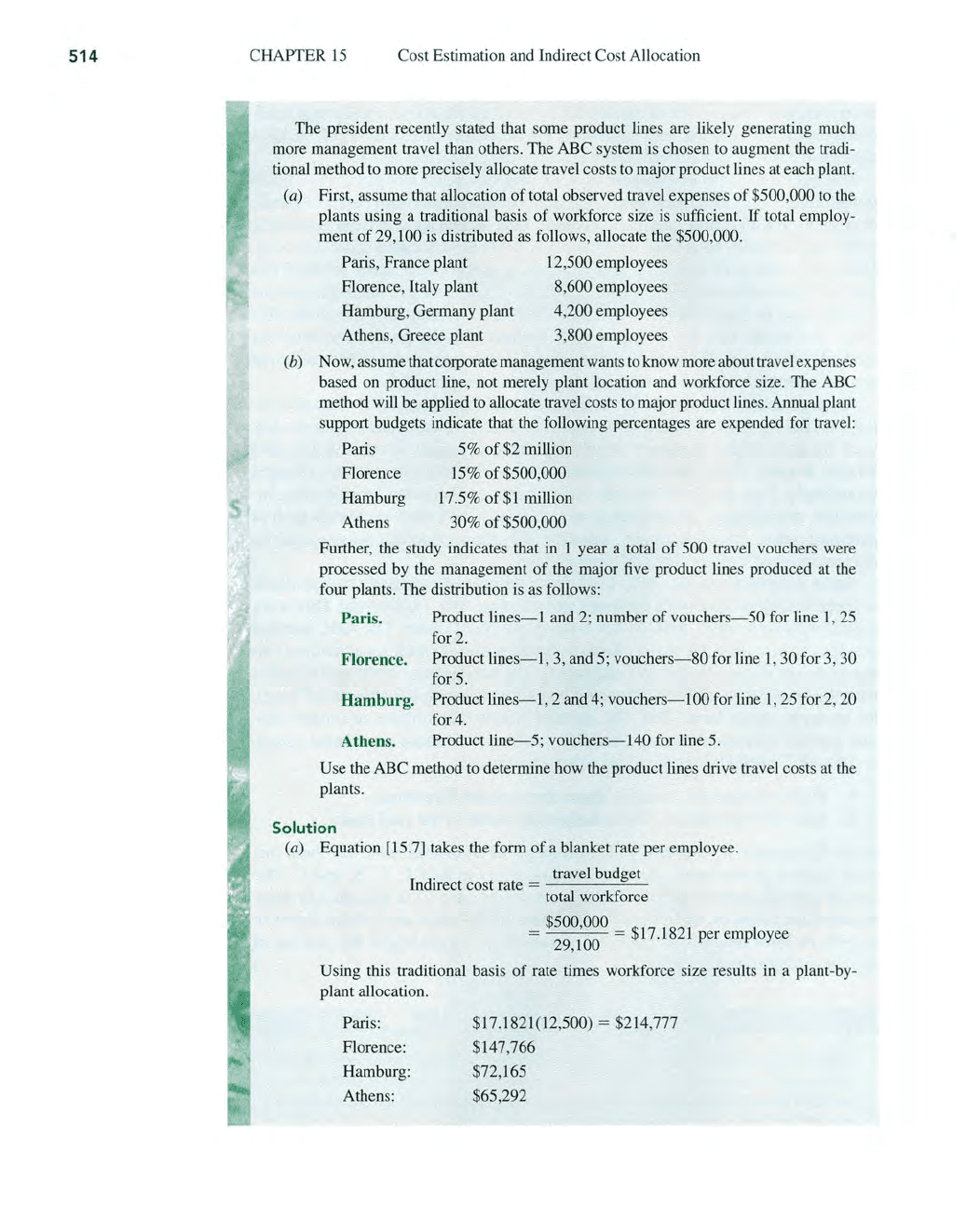
514
CHAPTER
15
Cost Estimation and Indirect Cost Allocation
The president recently stated that some product lines are likely generating much
more management travel than other
s.
The ABC system
is
chosen
to
augment the tradi-
tional method
to
more precisely allocate travel costs
to
major product lines at each pla
nt.
(a) First, assume that allocation of total observed travel expenses
of
$500,000
to
the
plants using a traditional basis
of
workforce size is sufficient.
If
total employ-
ment
of
29,100
is
distributed as follows, allocate the $500,000.
Paris,
France plant 12,500 employees
Florence, Italy plant
8,600 employees
Hamburg, Germany plant
Athen
s,
Greece plant
4,200 employees
3,800 employees
(b) Now, assume that corporate management wants
to
know more about travel expenses
based
on
product line, not merely plant location and workforce size. The ABC
method will be applied
to
allocate travel costs
to
major product lines. Annual plant
support budgets indicate that the following percentages are expended for travel:
Paris 5%
of
$2 million
Florence 15%
of
$500,000
Hamburg
Athens
17.5%
of
$1
million
30%
of
$500,000
Further, the study indicates that in 1 year a total
of
500 travel vouchers were
processed
by
the management
of
the major five product lines produced at the
four plant
s.
The distribution
is
as
follows:
Paris. Product lines
-l
and 2; number
of
vouchers-50
for line I, 25
for 2.
Florence. Product
lines-I
, 3, and 5; vouchers-
80
for line 1
,3
0 for 3, 30
for
5.
Hamburg. Product lines- I, 2 and 4; vouchers
-lOO
for Ii
ne
1,
25
for 2, 20
for 4.
Athens.
Product
line-5
;
vouchers-140
for line
5.
Use the ABC method to determine how the product lines drive travel costs at the
pl
ants.
Solution
(a) Equation [15.7] takes the form
of
a blanket ra
te
per employee.
travel budget
Indirect cost rate
= f
total work orce
$500,000
29,100 = $17.1821 per employee
Using this traditional basis
of
rate times workforce size results in a plant-by-
plant allocation.
Paris:
Florence:
Hamburg:
Athens:
$
17
.1821(12,500) =
$21
4,777
$147,766
$72,165
$65,292
